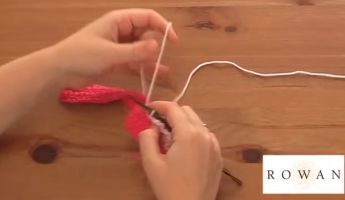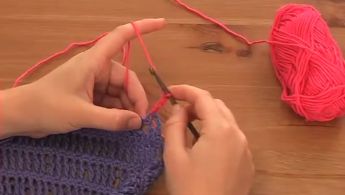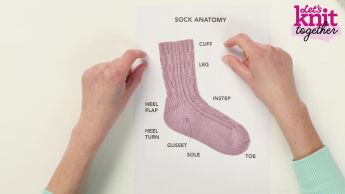Differences between yarn weights
video by
Let's Knit Together
- Overview
- Practical Guides
Yarn comes in a range of weights that relates to the thickness of the strand, so DK is a lighter weight than Aran, for example. This is turn relates to which needle size is recommended to use with each weight to produce a knitted fabric with the right drape and stitch density that is not too open and floppy or conversely tight and stiff.
There are several main yarn weights, and now that it is much easier to buy from other countries, there is a greater choice than ever. Remember that yarn weight is not linked to what the fibre is, you can have a DK yarn in manmade (acrylic), animal source (wool) or plant-based (cotton). Yarn manufacturers/spinners will usually state the yarn weight either in the title or on the ball band and will also include a recommended tension square and needle size over stocking stitch.
If you’re following a pattern and using the recommended yarn, you’ll have all the information you need in front of you. If you are substituting the yarn, this is where looking at the ball band for the tension square and needle size will help you to choose a suitable alternative.
Starting with the finest first, here is a list of yarns you are likely to encounter with a guide to needle size:
Lace and 2ply: 2-3mm needles
4ply: 3.25mm
Sport: 3.5mm
DK: 4mm
Aran: 5mm
Chunky: 6.5-8mm
Super-chunky: 10-12mm
Jumbo: 15mm+
Ball or skein size also varies, and due to the thickness of the strand, 25g of lace yarn may contain around 200m of yarn, whereas 25g of DK may have a meterage of 50m of yarn. Finer yarns tend to be sold in lower weights because they go further.
The thinner the strand, the smaller the needle size, and also the more stitches and rows you will fit into your 10cm x 10cm tension square in stocking stitch. However, lace-weight yarns may be worked on larger needles or even knitted with another strand, depending on the pattern. As a rule, as yarns get bulkier the needle range broadens, yet during these exciting times, the lines of classification can be blurred, as manufacturers create new yarns that fall between weights and designers play around with stitches and needle sizes to create their desired pattern. As ever, be guided by your pattern or ballband.
As we mentioned, different countries have different names for similar yarn weights, for example ‘worsted’ is about the same as Aran, ‘light worsted’ is as for DK and ‘fingering’ could be lace or up to 3ply. The best way to check for a comparison is to look for similar tension squares.
As your pattern will tell you which yarn to use, you only need concern yourself with comparing yarns if the one you want is not available or you want to choose something else. If this is the case, choose a yarn with the same tension, i.e. the same number of stitches and rows to a 10cm square and similar finer properties. If the best you can get is a close match, you’ll need to do a tension square and possibly adjust your needle size to match what is needed for the pattern.
The last thing to remember is that different brands may have a slightly different meterage, so you will need to work out how many metres of your new yarn you’ll need to match the original one. Do this by multiplying the number of balls by the meterage, e.g. 5 balls of 100m = 500m of yarn needed for the project.
TIP For any pattern, it’s important to achieve the recommended tension before you start, remember that if you have too many rows or stitches, go up a needle size, and too few, decrease your needle size.
If you have a stash of mystery balls, consider making a simple strand card with known yarns as a ready reckoner, then check with a tension square if you plan to use the mystery yarn.











































